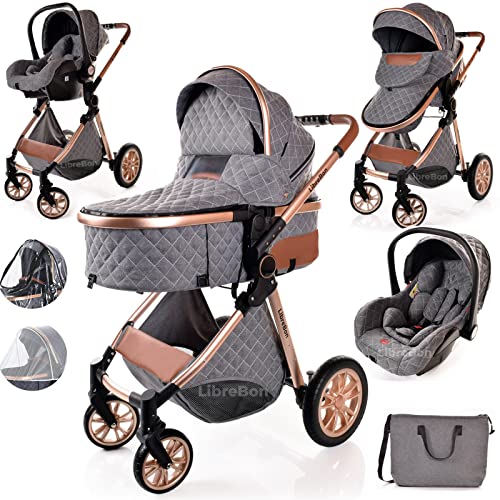Understanding Baby Prams and Pushchairs: A Comprehensive Guide
When it concerns looking after a newborn or a baby, couple of items are as important as a dependable baby pram or pushchair. These mobility help offer a safe, comfortable method to transport babies while enabling moms and dads and caretakers the freedom to browse the world. This short article explores the various elements of baby prams and pushchairs, helping moms and dads make notified choices about which item may be best suited for their household's needs.
What Are Baby Prams and Pushchairs?
Baby Prams: These are usually created for infants and really young babies. They have totally reclining seats that allow for a flat position, making them suitable for newborns. Prams frequently feature a big, deep body, providing additional defense and comfort.
Pushchairs: Pushchairs, likewise referred to as strollers, are more versatile and can normally be changed for toddlers as well. They are lightweight, simple to maneuver, and typically feature a variety of seating positions, including reclined and upright.
| Feature | Baby Prams | Pushchairs |
|---|---|---|
| Ideal Age | Newborn to around 6 months | Newborn to 3 years or more |
| Seat Position | Completely reclined | Adjustable (reclined and upright) |
| Weight | Heavier, more robust | Lighter, more compact |
| Folding Mechanism | More complex folding | Typically simpler folding |
| Maneuverability | Can be less maneuverable | Highly maneuverable |
Key Features to Consider
When selecting a baby pram or pushchair, prospective buyers must consider a number of essential features that can affect the usability and convenience for both the kid and the caregiver.
1. Safety Features
- Five-point Harness: Ensures the baby is securely strapped in.
- Brakes: Reliable braking systems prevent mishaps.
- Stability: A wide base and well-constructed frame boost stability.
2. Comfort
- Padding: Ample padding on the seat ensures convenience.
- Suspension System: Provides a smoother ride on uneven surfaces.
- Canopy: A large, adjustable canopy protects the baby from sun and rain.
3. Mobility
- Weight: Lighter models are simpler to raise and carry.
- Folding Mechanism: Easy folding designs enable for quick storage and transport.
- Compact Size: A more compact size makes it easier to suit vehicle boots and tight spaces.
4. Adaptability
- Convertible Options: Some models can be changed from a pram to a pushchair.
- Reversible Seat: Allows the baby to face the parent or the world, depending on choice.
- Devices: Look for choices that can accommodate automobile seats or have a storage basket.
5. Toughness
- Material Quality: Invest in higher-end products for durability.
- Weather Resistance: Water-resistant fabrics guarantee that the pram/pushchair can withstand numerous climate condition.
Kinds Of Baby Prams and Pushchairs
A number of kinds of baby prams and pushchairs meet various function requirements, lining up with parents' particular way of lives.
1. Travel Systems
Travel systems typically combine a car seat and a stroller in one package, enabling seamless transportation from car to pram or pushchair without disturbing the baby.
2. Umbrella Strollers
Umbrella strollers are light-weight and practical, designed for easier maneuverability. They are ideal for quick journeys and may lack some features found in full-size strollers.
3. All-Terrain Pushchairs
These are perfect for active families who enjoy treking or taking walks on rugged surfaces. They typically come with bigger wheels for stability.
4. Jogging Strollers
Jogging strollers are created for moms and dads who want to integrate workout with child care. They feature sturdy frames and fixed front wheels to enhance safety throughout a run.
The Importance of Choosing the Right Option
Choosing the appropriate baby pram or pushchair is not simply a matter of preference; it directly affects the security and comfort of the baby. Furthermore, the ideal option can profoundly affect the way of life of the caregivers.
Advantages:
- Convenience: A well-chosen pram or pushchair makes getaways simpler and more enjoyable.
- Health: Proper assistance assists in spine and skeletal development in babies.
- Bonding: Outdoors play a crucial function in parent-child bonding.
Regularly Asked Questions (FAQs)
1. At what age can my baby utilize a pushchair?
Most pushchairs are developed to accommodate babies as young as six months, although some models can be adapted to safely transfer newborns when used with compatible safety seat.
2. How do I maintain my baby pram or pushchair?
Regular cleaning is vital. Clean down the frame and fabric with a damp cloth and moderate soap. Periodically examine the wheels and brakes for wear and tear.
3. Can I utilize a baby pram for running?
Normally, no. Routine baby prams lack the stability and style needed for jogging. It is much safer to use a stroller particularly created for that purpose.
4. How do Visit Home Page select the best size?
Consider how often you will be utilizing the pram/pushchair and where. If space is limited, try to find a more compact design. For outdoor adventures, choose one with bigger wheels and good suspension.
Baby prams and pushchairs are indispensable tools for parents and caregivers, permitting safe and comfy transport of babies and toddlers. By understanding the numerous features, types, and benefits involved, caretakers can choose the very best mobility aid fit to their requirements. Whether it be a sophisticated travel system or a basic umbrella stroller, the best purchase can significantly improve the experience of being a parent, making outings satisfying and trouble-free for both parents and babies alike.

